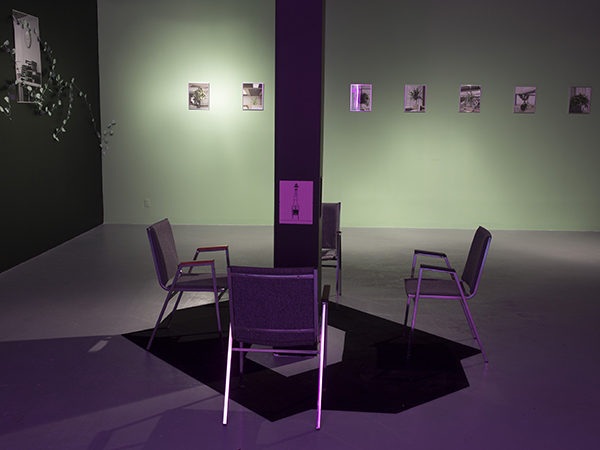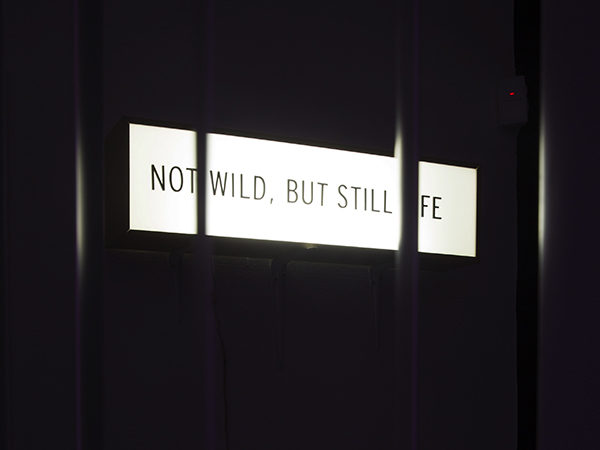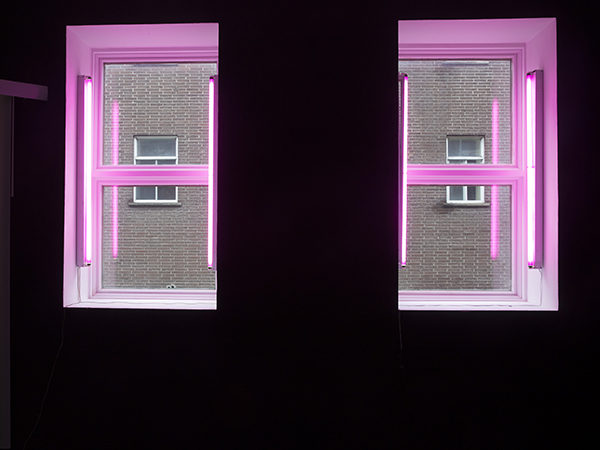In the fall of 2014, artist Nancy Samara Guzmán Fernández, along with teammate Rodrigo Frías Becerra, initiated a research residency on the bureaucratic system of the city of Quebec. The Édifice Marie-Guyard on Grande Allée avenue, the highest office tower in the city, was the location of their prospecting. Housing various ministries (Ministry of Education, sustainable development, environment and the Fight against climate change) this huge skyscraper overlooking Parliament Hill is a place where every day, different political strata evolve.

crédit photo: Ivan Binet
In her exhibition Not Wild, But Still Life, Samara invites the viewer to discover this administrative architecture through a personal interpretation of our diplomatic apparatus. Samara’s work questions the place of the individual in the political system. A work, which is based not only in Quebec City, place of production of her research residency at the chambre blanche, but also in her native City of Mexico. In her attempt to articulate a reflection on various countries bureaucracy and thus create a configuration, the result of her work in Quebec is imbued with a strange dreamlike atmosphere where remains a note of sadness. This impression of melancholy comes from the Samara’s desolation in the face something that happened in Mexico in September 2014: it casts in LA CHAMBRE BLANCHE gallery, the mourning and the grief she feels at the disappearance of 43 students of her country and of the Government’s carelessness towards the situation. The research she has undertaken in the Édifice Marie-Guyard during the night, takes the form of a performance in which she pays tribute to the missing students. She tells us, by the darkness in which she plunges us, the absenteeism of the judicial system and the lack of interest of the Government in the evolution of cases. At the same time, she captures different symbols and images presenting the course of her experience inside our own bureaucracy.

crédit photo: Ivan Binet
Initially, what her immersion in our political reality reveals, is not only its rational organization, but also the way human life is ordered so as to make our institutions “habitable”. Samara reflects the weakening of the state mechanism by the integration of the “living” in its project: Not Wild, But Still Life. Bureaucracy, this inherent fraction of the Governmental apparatus, is a place of organization of society, a location of translation of existence into documents, numbers and words.
The “living” becomes apparent in this exhibition by the deployment of a particular ecosystem that comes alive in an offbeat atmosphere: representations of plants decorate the environment and give life to a functional workplace, the black and white photocopy of a clock seems to stop time like a suspended dream, vertical blinds reflect the neon lights at night and create shadows where we imagine beings locked in cubicles.
This wild state denatured by the context in which it exists, questions the place of the bureaucracy and the impact of its functionalism on existence. LA CHAMBRE BLANCHE’s gallery is remodeled into a reinvented office, the stereotype of the robotic civil servant turned into a disturbing vision by the duality between the wilderness represented, and the automation of a complex built system. Flaws, crumbling, interfere in the structure in place, questioning it, weakening it.

crédit photo: Ivan Binet
The symbolization of the bureaucracy in the work of Samara leads us to reflect on the methods of governance and on the direction of the ministerial system dedicated to the edification of premises assigned to the organization of society. She furthers the reflection on the application of legislation to manage human existence (laws and standards) as well as on the operation of technological and media systems (television, radio, internet) which are now integrated to our private lives, our hobbies and our habitat. Michel Foucault names this exercise of power upon the citizen, the biopower. This sliding of the Government into reality settles in “bureaucratic” structures which are used to quantify, qualify, handle and capture the characterizations of a people in order to facilitate its governance, but also to keep it in the dark with the help of the administrative complexity. According to Samara, the political system appears to make the people feel secure, however it keeps it in a heavy regulatory world not easily accessible by the citizen. The Government apparatus consists of a system of justice, laws, standards, educational institutions, media, all kinds of ministries, disciplines and internal coding that complexify bureaucracy by cumbersome procedures.

crédit photo: Ivan Binet
Several journalists have compared the work of Samara to the literary works of Kafka. In his existentialist books, the author transports us to a world where realism and irony come together. The bureaucracy appears as a strange masquerade inside of which the main characters, often of ingenuous citizens facing the workings of power, experience absurd and hopeless situations in the face of a burlesque-like justice. Samara’s work transports us to a similar world, on the edge of absurdity, where there is a duality between the primitive and the predetermined aspect of living in society. We are immersed in a night without end with the impression of only see the part of the bureaucratic reality they want to show us. Samara invites us to question the aspect that justice can take just as Kafka in his book Le Procès (The Trial), that translate the deceptive power it holds over the citizen: “justice has a strange power of seduction, don’t you think?.”1
-
Kafka, Franz. 2009, The Trial. Oxford: Oxford University Press, 256 p.